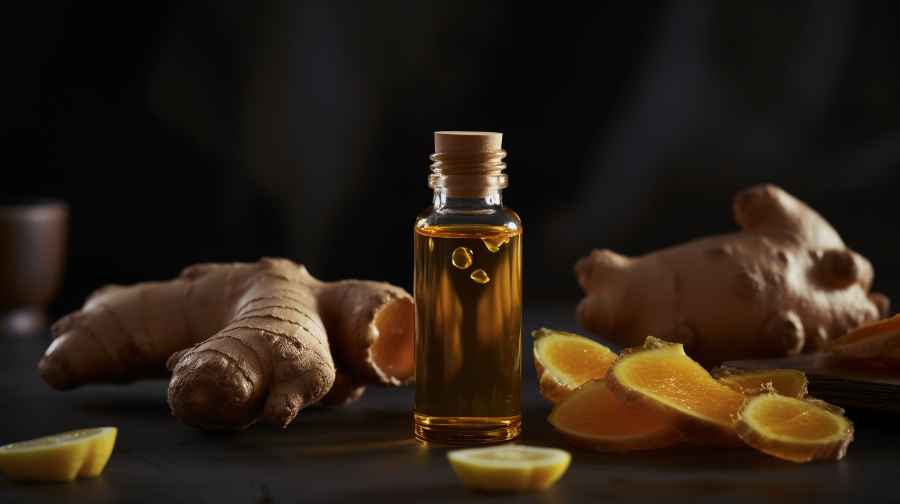Table of Contents - click here
ToggleGinger essential oil represents one of aromatherapy's most distinctive extracts, capturing the essence of the Zingiber officinale root in concentrated form. This pale yellow to amber liquid carries the plant's characteristic spicy warmth, backed by complex chemical compounds that have attracted both traditional healers and modern researchers. While its therapeutic potential extends from muscle care to digestive support, understanding its proper use and safety guidelines proves essential for anyone considering this potent botanical extract.
Essential Takeaways
- Ginger essential oil (Zingiber officinale) is a yellow-brown liquid extracted from fresh ginger root through steam distillation.
- The oil contains 20-30% zingiberene and other sesquiterpene hydrocarbons that give it its characteristic spicy aroma.
- Must be diluted with carrier oils at 2-5% concentration for safe topical use and requires patch testing.
- Research suggests potential benefits for muscle inflammation and exercise-induced pain when used properly.
- The oil's quality can be verified through specific measurements including gravity (0.870-0.882) and refractive index (1.488-1.494).
Latin Name
The Latin name for ginger is Zingiber officinale, from the Zingiberaceae family. This botanical nomenclature identifies the specific plant species used for ginger essential oil production.
The Latin classification Zingiber officinale distinguishes true ginger from other related species within the Zingiberaceae family. This taxonomic identification ensures correct plant material selection for essential oil extraction.
Spicy Yellow-Brown Liquid Root
Ginger essential oil is a pale yellow to amber-colored liquid obtained through steam distillation of fresh ginger root (Zingiber officinale). The oil contains zingiberene, camphene, β-phellandrene, and other sesquiterpene hydrocarbons as primary chemical constituents.
The viscous liquid has a specific gravity of 0.870-0.882 at 25°C and exhibits optical rotation between -28° to -45°. Its refractive index ranges from 1.488 to 1.494 at 20°C, distinguishing it from other root-derived essential oils.
Reduces Muscle Inflammation
While some studies suggest ginger essential oil may help with muscle discomfort, research specifically on topical use of ginger essential oil for muscle inflammation remains limited. A 2016 systematic review in the Journal of Pain Research found that oral ginger supplementation showed moderate evidence for reducing exercise-induced muscle pain, but more research is needed on topical applications.
If using ginger essential oil topically, it must be diluted with a carrier oil at a 2-5% dilution ratio (10-30 drops per ounce of carrier oil) to avoid skin irritation. A patch test should be performed before widespread use.
The oil contains zingiberene and other compounds that have demonstrated anti-inflammatory properties in laboratory studies, though their effectiveness when applied to skin requires further clinical validation.
Chemistry
Chemical analysis reveals that ginger essential oil contains sesquiterpene hydrocarbons as its major constituents. The molecular structure and chemical properties of these compounds contribute to its therapeutic effects.
| Compound | Percentage |
|---|---|
| Zingiberene | 20-30% |
| β-Sesquiphellandrene | 15-20% |
| β-Bisabolene | 10-12% |
| α-Curcumene | 6-8% |
These primary chemical constituents determine the oil's characteristic spicy aroma. Zingiberene, as the predominant compound, has demonstrated anti-inflammatory properties in laboratory studies.
General Safety Info
Basic Safety Guidelines for Ginger Oil
Ginger oil requires specific safety protocols for safe use. A patch test on a small area of skin must be performed 24 hours before general use to check for allergic reactions.
Essential safety measures for ginger oil:
- Must be diluted at 2-3% concentration with carrier oils for adult topical use
- Avoid direct contact with eyes, inner ears, and mucous membranes
- Medical consultation required before use if:
- Pregnant or nursing
- Taking blood-thinning medications
- Have diabetes
- Scheduled for surgery
Store in a dark glass bottle at room temperature, away from direct sunlight and heat sources.
Discontinue use and seek medical attention if experiencing:
- Skin irritation
- Rash
- Itching
- Signs of allergic reaction
Wrap Up
Ginger essential oil (Zingiber officinale) represents a potent botanical extract with established therapeutic potential. The amber-hued oil, rich in zingiberene and β-sesquiphellandrene, demonstrates promising anti-inflammatory properties for muscle discomfort when properly diluted. While research supports its traditional applications, users must exercise caution through patch testing and proper dilution protocols. Pregnant or nursing individuals should seek professional guidance before incorporating this aromatic root extract into their wellness routines.





